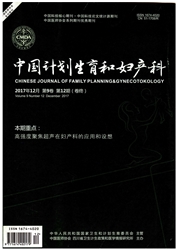

 中文摘要:
中文摘要:
目的 探讨不同康复方法对产后妇女盆底肌力的恢复效果。方法 选取深圳市宝安区妇幼保健院2015年1月至2016年3月足月阴道分娩6周后盆底功能评定异常的产妇400例为研究对象,根据患者意愿分为A、B、C 3组。A组130例行Kegel训练,B组130例在Kegel训练基础上加盆底生物电治疗,C组140例在B组基础上加低频脉冲治疗,治疗8周后对3组患者进行肌力评估。结果 C组总有效率(95.71%)明显高于A、B组(80.00%、86.92%),差异有统计学意义(P〈0.05);治疗前3组盆底肌力评分比较差异无统计学意义(P〉0.05),治疗8周后B、C组疗效优于A组,C组优于B组,差异有统计学意义(P〈0.05);治疗前3组生活质量评分比较差异无统计学意义(P〉0.05),治疗后评分改善,且B、C组高于A组,C组高于B组,差异有统计学意义(P〈0.05)。结论 盆底康复治疗中,Kegel训练联合低频脉冲及盆底生物电治疗疗效最佳,但盆底生物电治疗费用高昂,仪器设备沉重,需要产妇去医院,可操作性差,不利于在家庭中推广;低频脉冲治疗仪可有效缓解症状,提升盆底肌力,改善患者生活质量,且仪器携带方便、价格低廉,操作简单,值得推广。
 英文摘要:
英文摘要:
Objective To explore the effect of different rehabilitation methods on pelvic floor muscle strength of postpartum women. Methods 400 cases of maternal with full term vaginal delivery after 6 weeks of delivery from January 2014 to March 2015 in Maternal and Child Health Hospital of BaoAn District whose pelvic floor function evaluation were abnormal were selected as the study objects. According to the patient~ intention they were divided into 3 groups:group A, B and C. Group A of 130 patients underwent Kegel training, group B of 130 patients underwent Kegel training based on pelvic floor biological electric treatmen, and Group C of 140 patients were treated with low frequency pulse therapy on the basis of treatment of group B. After 8 weeks of treatment, muscle strength was assessed in 3 groups of patients. Results The total effective rate of group C (95.71% ) was significantly higher than that of group A and B ( 80. 00%, 86. 92% ). The difference was statistically significant ( P 〈 0. 05 ) ; There were no significant differences in anterior pelvic floor muscle strength scores before the treatment among the 3 groups ( P 〉 0. 05 ) ; 8 weeks after treatment, the scores of group B and group C were better than that of group A, and group C was better than group B. The differences were statistical significant ( P 〈 O. 05 ) ; There were no differences in Quality of Life ( QOL ) scores among the 3 groups before treatment ( P 〉 0. 05 ). It significantly improved after treatment, with group B and group C better than group A, and group C was better than group B. The differences were statistical significant ( P 〈 0. 05 ). Conclusion In the pelvic floor rehabilitation therapy, Kegel training combined with low frequency pulse and pelvic floor bioelectric therapy is the best. But the pelvic floor bioelectric treatment costs are high, with heavy equipment,the need for maternal to go to the hospital and poor operability, it is not conducive to the promotion in the family; Low frequency pu
 同期刊论文项目
同期刊论文项目
 同项目期刊论文
同项目期刊论文
 期刊信息
期刊信息
